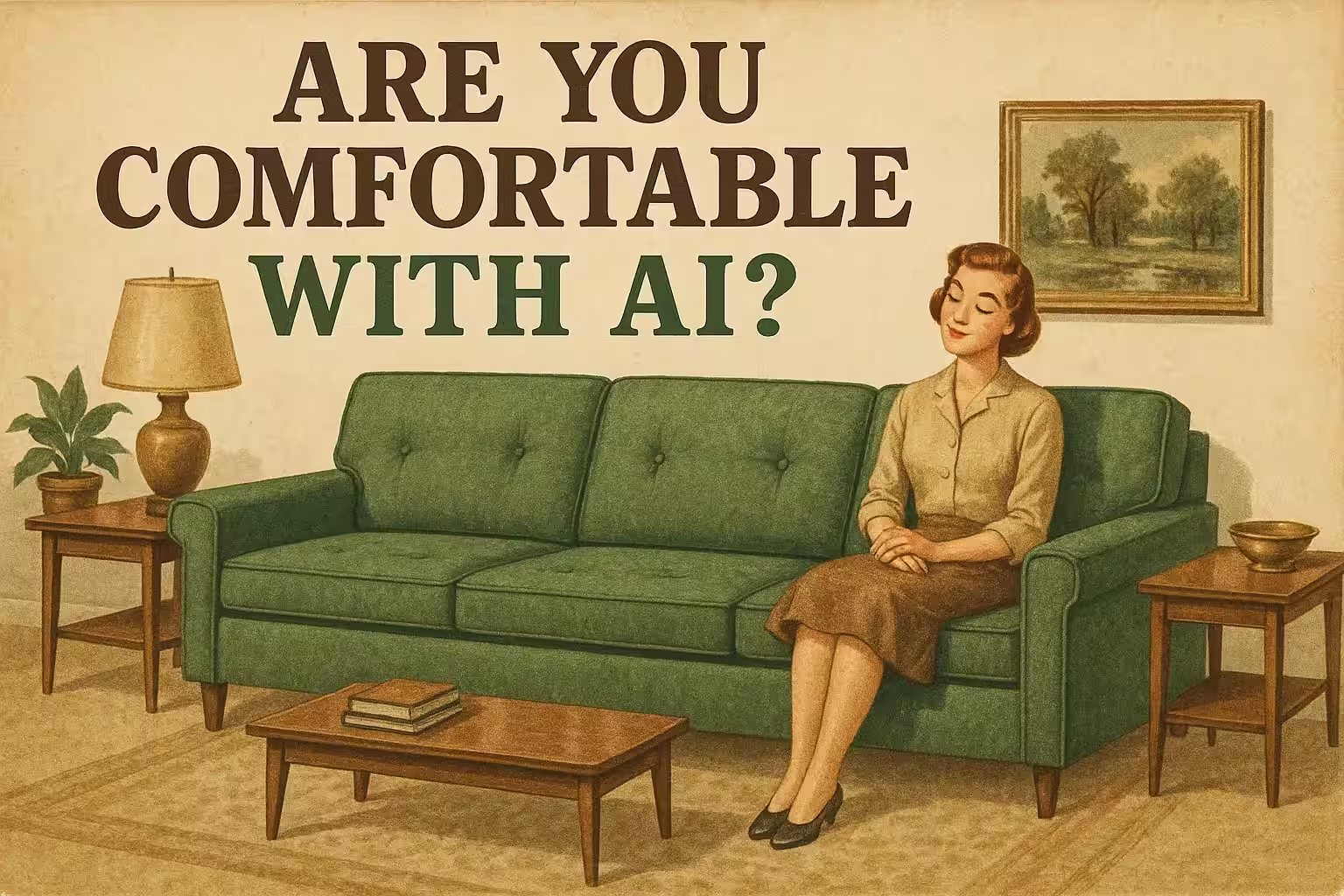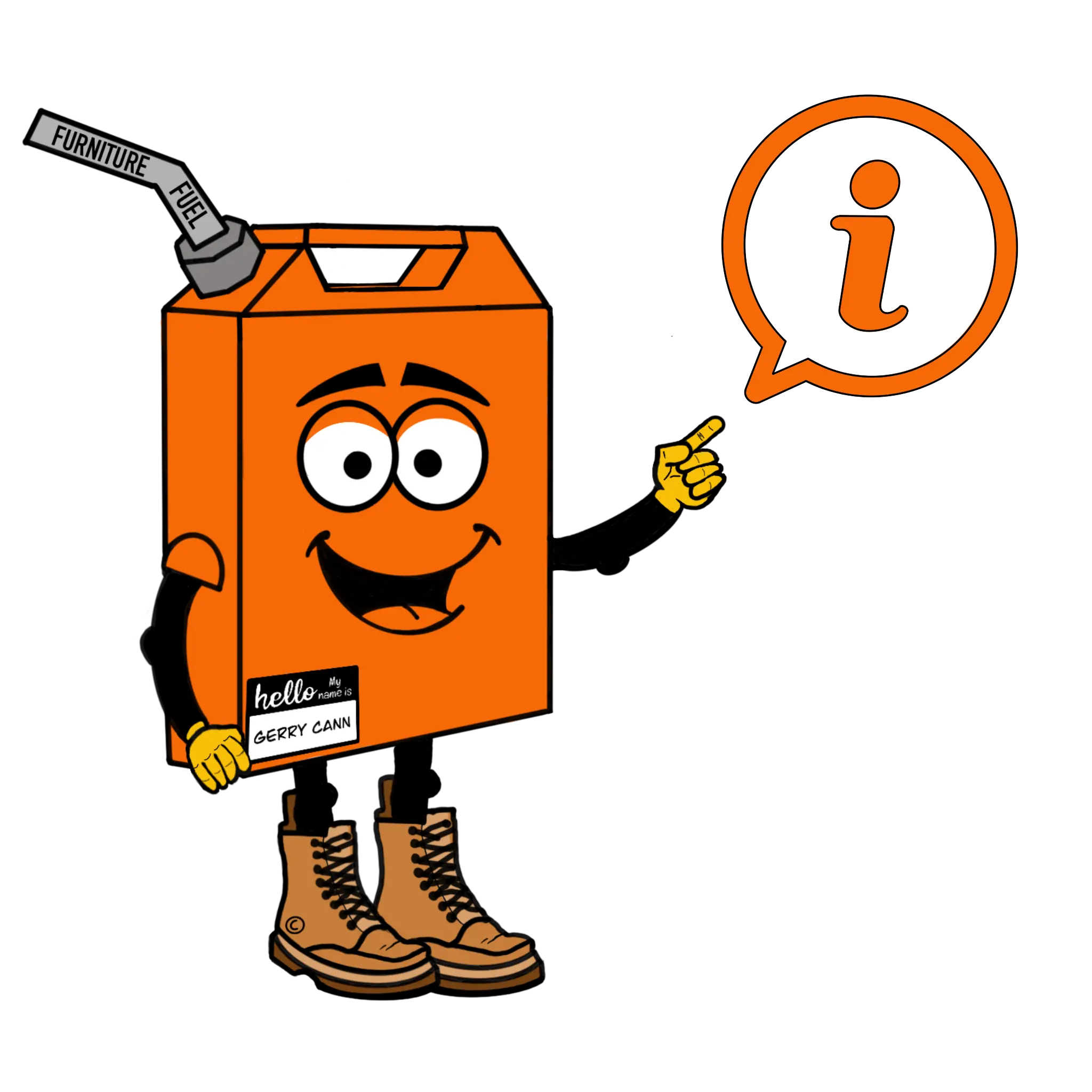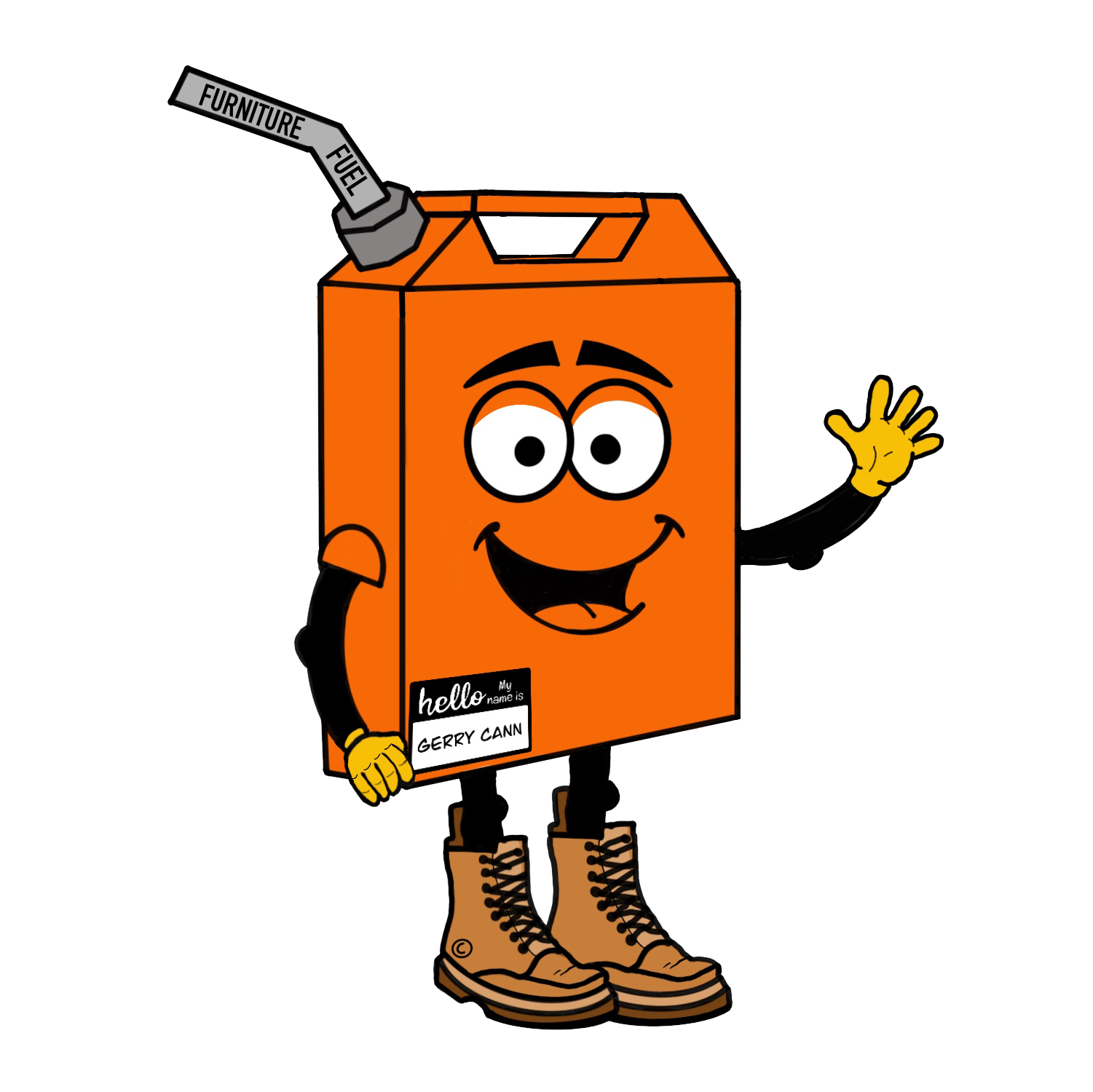So yes, there’s no doubt AI can be hugely beneficial when it’s implemented thoughtfully. There’s no argument there. But like any powerful tool, it demands careful handling.
Is AI in Furniture Retail Helpful or Just Hype?
Jack Young
Business and Marketing Consultant | Dip DigM | BA Business Management
- Last Updated: 21 May 2025

The image above was created with AI.
The prompt: A vintage-style ad of a living room, with a green sofa and the title, Are You Comfortable With AI?
Table of Contents
Key Takeaways – Is AI Helpful or Hype
- AI isn’t evil—it’s a tool and, like any tool, its usefulness depends on how it’s used. It’s about support, not replacement.
- AI can be useful in furniture retail, helping with content, customer service, analysis, and internal tasks—but only if implemented thoughtfully.
- Don’t fall for hype. If your business fundamentals are unstable, AI won’t save you. It’s not a magic wand.
- AI can help level the playing field, especially for smaller retailers, but it won’t replace quality, authenticity, or trust.
- Your customers can often spot AI-generated content, which might hurt your brand if overused or done poorly.
- Not using AI may become a strong differentiator, especially when it comes to human touch and genuine experience.
- Evaluate AI like any other tool. Will it improve the customer experience or just add friction? That’s the real question.
TLDR - Core Summary: Is AI Helpful in Furniture Retail?
AI, particularly tools like Large Language Models (LLMs), offers significant benefits for tasks like data analysis and customer service. It can help furniture retailers compete with larger companies. However, AI can’t fix core product or service issues—it’s a tool, not a saviour.
The concern is that businesses may focus on using AI without fixing the basics first, or worse, AI may negatively impact customer experience, particularly if it becomes too common or inauthentic. While AI-generated content may be useful, it can sometimes feel impersonal. There’s also the broader concern of rapid AI adoption potentially leading to job displacement without a reasonable transition period for workers, It may not offer the luxury of gradual change.
In furniture retail, AI could transform areas like personalised shopping, logistics, and inventory management. However, it must be carefully evaluated for its true benefits and potential trade-offs. Ultimately, AI’s success lies in its relevant integration into business processes, ensuring it enhances rather than replaces the human touch.
AI: The Rise of the Machines… and Marketing Emails
AI or Artificial Intelligence. The buzzword of the moment. AI gets a bad rep, but it isn’t inherently evil, even if decades of Hollywood movies have conditioned us to imagine Skynet and Arnold Schwarzenegger every time the topic comes up. There are serious benefits to using AI, but like any tool, its value depends entirely on how we use it. And let’s face it, we humans aren’t always the most efficient.
Every day, another app or platform seems to drop into your inbox, boasting a new AI feature. “Now with AI!” they shout. Woohoo! We… are meant to shout. It can feel like everyone’s adding it in somewhere, so you might be wondering—should I be doing the same?
The AI Everyone’s Talking About and… the Others
Most AI models that you hear about in the news and that are available for public use are called LLM’s or Large Language Models. These models have been trained on us, humans. Meaning they are trained on vast datasets consisting of human-generated text, which could include books, articles, and other written materials. Any output, while it may be “unique”, is a combination of patterns and knowledge from numerous pieces of content.
LLMs need reliable data. The quality and reliability of training data significantly impact their performance and accuracy. Biases or inaccuracies in the training data can lead to flawed outputs or hallucinations. This is why fact-checking AI outputs is still important.

An AI hallucination occurs when an AI model — particularly a large language model — produces content that sounds correct but is false or not grounded in reality. These hallucinations often arise due to gaps or biases in the training data or the probabilistic nature of language generation, where the “most likely” next word or topic isn’t always the factually accurate one.
Inputs, known as prompts, have an important role to play in the output. The quality and accuracy of the output heavily depend on the input provided. Clear and well-structured prompts guide LLMs to generate more accurate and relevant responses, while vague inputs can lead to less useful outputs.
What’s Good about AI? The Positives
I recently read an article from The Independent that women are turning to AI for therapy. Another from the BBC discussed women in China doing the same. Using AI for therapy might sound alarming—or encouraging—depending on your perspective. I do think that a lot of the concerns raised in The Independent article hold true.
However, I see it as encouraging. If someone’s anxious about judgment or simply can’t afford private therapy (we all know how stretched the NHS is), AI can be a helpful first step. Even if it’s not a real therapist, it can calm the mind and guide them to useful content. That’s progress, versus staying in the loop of negative thoughts.
AI therapy should be similar to over-the-counter medication. Useful as a first step, but if symptoms persist, see a professional.
My Personal Use of AI
I have used AI to clarify my thinking, especially when I’m making connections between new, distant or unrelated fields. Once I’ve mapped something out, I’ll ask AI: Do you see what I see? I have many great people in my life who are extremely knowledgeable, but they don’t always have the same background or context to give useful feedback, and AI doesn’t worry about hurting my feelings.
I’ve even used AI to develop a plan of action for some recent health issues. My GP is exceptional, but with NHS services being strained, the only realistic solution was long-term medication, one I’d rather avoid. AI helped me find potential solutions. Which so far seems to be working.
Again, always seek proper medical advice for your treatment, as professional advice should be part of the process. In my case, AI was worth trying after I had ruled out anything serious.
Overall, I see AI in a similar light to how Steve Jobs saw computers.
“I think one of the things that really separates us from the high primates is that we’re tool builders. I read a study that measured the efficiency of locomotion for various species on the planet. The condor used the least energy to move a kilometer. And, humans came in with a rather unimpressive showing, about a third of the way down the list. It was not too proud a showing for the crown of creation. So, that didn’t look so good. But, then somebody at Scientific American had the insight to test the efficiency of locomotion for a man on a bicycle. And, a man on a bicycle, a human on a bicycle, blew the condor away, completely off the top of the charts.
And that’s what a computer is to me. What a computer is to me is it’s the most remarkable tool that we’ve ever come up with, and it’s the equivalent of a bicycle for our minds.” Source: Memory & Imagination: New Pathways to the Library of Congress, 1990.
Steve Jobs’ analogy of the computer being “a bicycle for our minds” suggests that he viewed computers as tools that enhance and extend human capabilities, much like how bicycles amplify human physical abilities.
Humans and technology should be collaborative, complementing each other to achieve greater outcomes. Computers are meant to enhance human intelligence and creativity rather than replace them. Humans and AI should not be different.
Maybe in time, AI will become how Jobs saw computers. A HBR article, How People Are Really Using Gen AI in 2025 by Marc Zao-Sanders suggests that AI may be getting used as an aid to improving and enhancing human lives vs replacing them.
“Therapy (more on this one later) is the new top use case. There are two other entrants in the top 5: “Organizing my life” and “Finding purpose.” These three uses reflect efforts toward self-actualization, marking a shift from technical to more emotive applications over the past year.”
But enough about me and Steve Jobs—what about your furniture business?
How Can AI Help My Furniture Business?
AI is far-reaching and is transforming many areas of the world, there are very few that aren’t touched by it in some way, shape or form and furniture retail is no exception.
- Content & Marketing Efficiency – AI writing tools can help create product descriptions, marketing emails, ads, and blog content outlines.
- Data Organisation and Analysis – AI can quickly analyse customer reviews or survey feedback to help you spot patterns, like repeat delivery issues or standout compliments.
- Customer Service (Light-Touch) – Chatbots powered by AI can handle common customer queries: delivery info, return policies, product specs—especially useful outside normal hours.
- Image & Room Visuals – Mocked up styled rooms or lifestyle shots.
- Helping with General Business Tasks – AI can help you draft emails to customers, define your strategy, or sanity-check your ideas.
The examples above highlight some of the simple tasks AI can assist with, but the possibilities are virtually endless. If you’re able to create your own algorithm using input from an LLM, you could build something unique and tailored to your business.
But this article isn’t here to discuss features of certain tools or sell you on AI. It’s here to offer an alternative perspective—something beyond the hype.
The Risks and Realities of AI in Furniture Retail
AI has real potential for businesses. But let’s not get carried away. Slapping “AI” onto every product will become old. It already is for me. Fix the basics first. If your core offering doesn’t work, no amount of AI bells and whistles will save it.
Before implementing AI, it’s important to consider the trade-offs. Take customer service, for example. Using AI chatbots for customer support is likely to be the first area of mass adoption in the industry, and we’re already seeing this. The argument for their implementation often boils down to this: “It’s not about replacing humans but about freeing them up to focus on more complex issues.”
Now, while there is a degree of truth to that, if someone interacts with your AI model and it doesn’t help, keeping them in a constant loop of “was that helpful?” and only adds to their frustration, is it really beneficial? You will probably have experienced “helpful” chatbots on telecommunications and insurance websites, the ones that make you want to use carrier pigeons and walk everywhere. Do you want that same experience for your customers?
Chatbots can be beneficial, but as they become more common, not using one could become a point of differentiation for your business. In a world of robotic “Hi, how can I help you?”, a real human ‘Hello’ might stand out. It shows you value human interactions, connections with your customers.
It’s also worth noting that the distinction between chatbots (fully AI) and live chat (eventually involving a human) is an important part of the customer experience. The quality of the AI, how smoothly the hand-off to a human happens (if it does), how transparent you are about the interaction being AI-only, and the kind of help a customer actually needs all play a role. A well-designed customer service strategy often blends both approaches to balance efficiency with customer satisfaction.
Authenticity vs AI in Furniture Content Creation?
AI content creation is another area seeing increased use, both in writing and image generation. But let’s cut through the hype. AI-generated content has the potential to be off-putting to readers.

The image above was created with AI. The prompt: An AI robot making a living room lifestyle picture.
An article by Search Engine Journal discusses a study by marketing consultant Joe Youngblood. The study revealed that U.S. consumers could correctly spot AI-generated images 71.63% of the time when shown side-by-side with real photos.
“We did a recent study with over 4,000 American consumers ranging from age 18 to 65. The study tasked our participants with selecting which one of two photos was generated by AI.
The results showed that when asking them to determine which photo was real and which one was AI, over 70% of consumers on average could correctly select the AI generated image.
In all but 2 tests the percentage of respondents correctly selecting the AI generated photo were extremely high. However, when it came to selecting a photo of the Eiffel Tower in France or a painting of George Washington, the respondents failed much more frequently.
On average our respondents were able to detect the GenAI created image 71.63% of the time” Source: Joe Youngblood, Study: American Consumers Are Not Fooled by AI Generated Images, 2025
Check the study out for yourself. The George Washington photo would have got me. Maybe if I looked at the frame in detail, I probably would have said AI, but at a glance, no.
Youngblood’s article goes on to suggest,
“If consumers determine that AI images are poor quality or a bad fit, they may hold that against your brand/product/services. High-quality custom imagery, videography, and photography then is still the best solution when viable.”
“When viable” is a valid point. High-quality custom imagery is still the gold standard for establishing authenticity, but it’s not attainable for every business. This makes AI imagery attractive, particularly for lean, e-commerce-only businesses. For brick-and-mortar stores, it’s an option—but then so is taking a simple product shot in-store.
Can You Use AI to Write Content?
Also cited in the Search Engine Journal article was a report by Hookline& titled: “Does anyone want to read AI content?”

Source: Does anyone want to read AI content?, Hookline& Study, 2025
The report showed that 82% of Americans can detect AI-generated content, and this negatively impacts brand perception for a significant 40% of consumers. While nearly half (49.5%) report no change in opinion, this neutrality doesn’t outweigh the potential for reputational damage, especially among older adults (44.5% negative). Only a small 10% see AI content as a positive for brands.
AI can help you create a proportion of your content and level the playing field against bigger retailers. But the question that needs to be asked is: Does it help your business—and most importantly, your customers?
Using AI for furniture product descriptions (with a bit of editing) is better than having no descriptions at all, and likely to go unnoticed. But for longer pieces of content, the kind that build trust with your audience, it’s better to use AI to brainstorm and structure your ideas.
It can make life easier and help you compete. But people still connect with authentic content. Is the convenience worth the risk of losing that human touch and turning people away with content that doesn’t feel real?
Does Google Care About AI Content?
Google’s E-E-A-T framework (Experience, Expertise, Authoritativeness, Trustworthiness) is ultimately designed to assess whether content feels authentic. You must be authentic to be trusted. By having genuine experience and expertise to share, you are authentic—you’ve been through what you’re discussing.
Maybe soon to be E-E-A-A-T: Experience, Expertise, Authoritativeness, Authenticity, Trustworthiness. And perhaps “Thoughtfulness” will sneak in next for good measure.
Joking aside, while authenticity might not officially be part of the acronym, it’s very much in the spirit of what Google’s trying to reward, especially with its growing emphasis on helpful, human-first content.
AI content is already a measure of quality in Google’s eyes.
“The Lowest rating applies if all or almost all of the MC on the page (including text, images, audio, videos, etc) is copied, paraphrased, embedded, auto or AI generated, or reposted from other sources with little to no effort, little to no originality, and little to no added value for visitors to the website.” Source: Google’s Search Quality Evaluator Guidelines
What’s important here is the phrase “all or almost all MC (main content).” Used sparingly and as long as it’s helpful, AI-generated content is acceptable.
Google clarifies this further on page 43 of the guidelines:
“Important: Copying, paraphrasing, embedding or reposting content does not automatically make a page Lowest quality. However, the Lowest rating is required when all or almost all of the MC on the page (including text, images, audio, videos, etc) is copied, paraphrased, embedded, or reposted with little to no effort, little to no originality, and little to no added value for website visitors. Likewise, the use of Generative AI tools alone does not determine the level of effort or Page Quality rating. Generative AI tools may be used for high quality and low quality content creation. For example, a high level of effort may be involved in creating high quality original artwork using Generative AI tools. However, it’s also possible to use Generative AI tools to create Lowest quality content with little to no effort, little to no originality, and little to no added value for website visitors” Source: Google’s Search Quality Evaluator Guidelines
If authenticity becomes the standard of quality content evaluation, AI imagery will struggle to compete with content from the real world. Customers will value room settings that you’ve carefully created—with real products that are actually for sale. These images don’t just show off the main product—they help your customer visualise how everything fits together. A sofa, a lamp, a side table: you’re helping them get closer to a decision.
And with Google’s continued push into AI image search with Google Lens, this may make your “own” AI-generated room settings may become redundant, or at least less important than simply helping customers find the right product faster.
A note on image rights: If you’re using AI to generate product or marketing images, be aware that—unless you add your own original creative content—those images may not be protected under UK copyright law or the laws of many other countries. This means a competitor selling the same sofa, for example, could legally reuse your AI-generated image without infringing intellectual property rights, at least under current legal guidance. Additionally, even if the AI platform claims to give you full usage rights, it’s not always clear whether it has the legal right to use all the material in its training data. Most platforms’ terms and conditions also shift legal responsibility for any copyright infringement onto the user, not the company. Until there’s legal clarification, it’s wise to add unique creative elements or combine AI images with human-made content to better protect your assets and reduce legal risk.
Update (May 2025): The UK government is currently consulting on changes to copyright law that could allow AI firms to train models on copyrighted material without permission, despite strong opposition from creatives and industry figures. The proposal remains controversial, and the final outcome is uncertain. Until there’s legal clarification, the advice above still applies.
What Might Furniture Retail AI Look Like in the Future?
Imagine this: your personal AI assistant knows everything it needs to about you. Paint colours in your home. Floor type. What shows you watch. Your Pinterest boards. Whether you’ve got back pain. How much spare income you have. Whether you prefer furniture as a statement piece or something practical. Based on all this information and more, all you need to say is, “I need a new sofa.”
Your AI then talks to the AIs of different retailers. It returns a top-three list tailored to you. MOT due? Holiday booked? Maybe then it opts for finance to protect your cash flow. No hard sell. Just a seamless experience.
Supplier AI systems talk to retailer systems, placing orders when stock is running low. What of Logistics? Also handled by AI. Self-driving delivery vehicles. Maybe even robot unloaders. Your own personal Cyberdyne Systems Model 101, also known as a T-800 Arnold model, unloading and delivering your furniture whilst keeping futuristic, T-1000 models, coming for you.
This might sound utopian—or dystopian—depending on your point of view. But it’s not impossible. Well, maybe the Cyberdyne Arnold. But voice assistants, online shopping, or AI itself just a few years ago seemed farfetched. And as for personal AI assistants—well, they already exist to a degree.
AI and the Bigger Picture: What Actually Concerns Me
As I’ve said, AI, in general, does not concern me. What does, however, is the speed of adoption.
Economist Joseph Schumpeter coined the term “creative destruction”—the process by which new innovations wipe out old industries, making way for progress. Think about the change from the horse-and-carriage to the horseless carriage or motor car. It wasn’t instant. People had time to retrain. Carriage drivers could become chauffeurs. Or, at the very least, found other employment. The transition was gradual, giving people the chance to adjust.
AI hasn’t offered us that luxury. In just a few short years, it’s impacted countless areas. Jobs are being reshaped before we’ve even had time to understand the full implications.
If we woke up tomorrow to AGI (Artificial General Intelligence)—a form of human-like intelligence—many industries would be transformed or even become obsolete within the next 8 months or so, at least in my estimation. Jobs would be displaced at such a rapid pace that no reasonable transition could keep up.
This scenario is extremely unlikely, though. If there were mass job losses across a large proportion of society, it would mean reduced or no income unless people found employment elsewhere. And without income, who’s left to buy the products or services from the businesses that replaced them with AI, never mind the societal backlash that would follow?
Even on a smaller scale, AI could be contributing to cognitive decline, which could lead us towards something closer to Idiocracy, a satirical film about a society where intelligence has sharply declined. If you haven’t seen it, it’s worth a watch. It suggests that Skynet might not be our biggest concern.
There are, however, a few reins on AI advancement at the moment.
AI Recipe... Tasty?
Would this stop you from buying this snack? Could this be the end of Grandma’s recipe?

Source: Reddit Forum – r/mildlyinteresting
AI Is Bottlenecked and That’s a Good Thing
AI is hitting bottlenecks.
Modern LLMs are trained on vast amounts of historical and current content. But with the rapid rise of AI-generated material, there’s a growing risk that future models will end up learning from the outputs of earlier AIs. Since these models rely heavily on patterns in existing data, it could create a feedback loop where originality steadily declines and ideas are endlessly recycled—a loop of AI learning from AI. Add in the legal challenges from publishers suing AI firms over copyright issues, and future training could be restricted even more.
Then there’s energy.
AI is incredibly power-hungry. Elon Musk warned of an “electrical drought”. And on that point, I think he’s right. In an article written for Scientific American, the cost of AI to the environment was investigated.
“Big tech companies typically do not disclose the resources required to run their models, but outside researchers such as Luccioni have come up with estimates (though these numbers are highly variable and depend on an AI’s size and its task). She and her colleagues calculated that the large language model BLOOM emitted greenhouse gases equivalent to 19 kilograms of CO2 per day of use, or the amount generated by driving 49 miles in an average gas-powered car. They also found that generating two images with AI could use as much energy as the average smartphone charge. Others have estimated in research posted on the preprint server arXiv.org that every 10 to 50 responses from ChatGPT running GPT-3 evaporate the equivalent of a bottle of water to cool the AI’s servers.
Such demands translate to financial costs. John Hennessy, chair of Google’s parent company Alphabet, told Reuters last year that an exchange with a large language model could cost 10 times more than a traditional search, though he predicted that those costs would decrease as the models are fine-tuned. Analysts at Morgan Stanley estimated that if AI generated 50-word answers in response to 50 percent of queries, it could cost Google $6 billion dollars per year. (Alphabet reported $300 billion in revenue in 2023.)” Source: Scientific American, What Do Google’s AI Answers Cost the Environment?, Allison Parshall, June 2024
While concerns about an “electrical drought” are valid, the current situation in the UK highlights another key factor in the energy debate. As Power Technology recently pointed out, the UK is already struggling with the limitations of its national grid in handling the growing output of renewable energy.
The irony of paying wind farms not to operate stresses an important point. While AI’s energy consumption is a concern, our existing infrastructure is already unable to make full use of the clean energy we do have. The billions in grid constraint payments—projected to hit £1.8bn by 2025—highlight an urgent need for investment in energy storage and transmission, not just generation.
If your furniture business promotes sustainability, whether in operations or product offerings, the energy consumption side of AI is something worth factoring into your wider strategy.
AI’s energy use is rarely considered when businesses adopt it. If you’re using AI to write blogs about how eco-friendly your products or services are but overlook the energy footprint of the tools themselves, you risk undermining your message.
So, Is the Future of Furniture Retail… AI?
I don’t believe so. Not its salvation, anyway.
We are all humans after all, and biology compels us to seek human interaction. Furniture purchases are often emotional decisions tied to self-expression and social connection. While digital tools like AI can assist, human interaction remains important for building trust and addressing complex customer needs.
AI already is or will become part of your business in some capacity, whether you want it to or not. We’re seeing it in personalised recommendations, virtual showrooms, AR and Google search results. But the goal isn’t to rush in and slap AI onto everything, calling it innovation.
AI is most effective when enhancing customer engagement, optimising inventory, and improving personalisation. So, take time to understand where it adds real value—for your customers, for your business, and for your sanity.
If it makes your life easier and adds value to the customer, great. If it’s just adding bloat to a broken product, skip it.
Finally, remember to pay attention to how quickly AI is being adopted—and whether the status quo it replaces allows room for people to adapt. If not, this could strongly impact your business.
Our weekly newsletter provides digestible content on business strategy, marketing tactics, and behavioural economics designed to fuel your furniture business. Written by a human.
Pleasant Green — Don't Buy Stuff from Old AI People
I wanted to share this Pleasant Green video from YouTube. While it gave me a few laughs, it does show the dangers of AI and a case for a resurgence of brick-and-mortar stores.
Related Articles
How to Use Net Promotor Score to Get Customer Feedback About Your Furniture Business
Choose How Your Furniture Business Will Compete – Low Cost, Differentiation or Focus
How to Build and Sustain Customer Loyalty in a Competitive Furniture Market
How To Come up With Ideas for Your Furniture Business – The James Webb Young Technique
Was this article helpful?
YesNo


